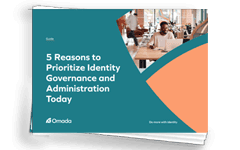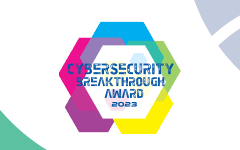Let's Get
Started
Let us show you how Omada can enable your business.
• Full-featured IGA
• Configurability without code
• Best-practice framework for solution design and deployment
• High degree of configurability
• Intelligent compliance
• Manage identities and access across hybrid platforms
• Support at every step of your IGA journey
• Personalized service package to accelerate your deployment
• Avoid common pitfalls and get value in 12 weeks
• Iterative implementation roadmap
• Standardized, well-documented best practices
• Support from Omada-certified project managers, architects, and consultants
• Stellar Customer Success Team
• Quick and professional Service Desk
• Access to ITSM system and KPI reports
• Digital self-paced and instructor-led courses
• Training on demand through our Premier Academy subscription
• Individual, role-based learning plans and certification paths
• Ensure fast and successful IGA deployment
• 5-step process with clear exit criteria
• 12 weeks time to value
• Helps support enterprise IT security
• Makes it easier to meet compliance mandates
• Automates access provisioning and enables the workforce from day 1
• Automated access provisioning and deprovisioning
• Least privilege and separation of duties policies
• Simple-to-run certification campaigns
• Access compliance status dashboards
• Cross-system certification campaigns
• 50+ audit report templates
• Identity lifecycle management
• Automatic access provisioning
• Self-service access requests
Omada provides Governance for Identity Fabric ensuring compliance regulations are met, security and efficiency around identity workflows are maintained.

A definite guide to Identity Governance and
Administration best practices. Learn how to
successfully deploy and maintain an IGA solution.

Our comprehensive Identity and Cybersecurity
glossary, featuring extensive explanations, real-life
examples, practical frameworks and everything else
you need to understand key concepts in identity and
cybersecurity.

In this Guide, Gartner has identified Omada as a
Representative Vendor in IGA. Use it to evaluate top
Identity Governance vendors and anticipate future
trends, features, and capabilities in the IGA market.

Familiarize yourself with the typical threats that
can derail a seamless legacy to cloud migration of
IGA functionality and get tips on managing them.

As part of their digital transformation, DEKRA moved
from an in-house access management solution to
a modern, cloud based Omada IGA solution.

Get practical examples and data proving the
value of IGA and learn the five key reasons you
must make it a business imperative today.

Explore our white papers on compliance, security, and
efficiency topics. Gain insights and best practices to drive
informed decisions and enhance your organizational strategy.

We are constantly adding new features to Omada
products to ensure your IGA efforts keep pace with
the ever-evolving threat landscape.

Get information about the newest Omada product
features, benefits, and use cases to ensure you get
the most from your IGA program.

Participate in interactive product demos covering
capabilities such as Delegate Access, Request
Access, Approve Access Request, and more.

Get the latest IGA trends, information, and intelligence
from renowned industry experts in Omada’s live and
on-demand webinar presentations.

A market-leading provider of identity governance
and administration solutions. Get to know us better!

At Omada, efficient teamwork creates extraordinary results.
We enable talented people to create career paths where
they can thrive, be inspired, and have fun.

Omada partners provide unmatched advisory, product
and service re-sale, and project delivery resulting in
unsurpassed customer satisfaction scores.

Don’t just take our word about the value of Omada
solutions. See what actual users think.

See what the media are reporting about our
innovative identity governance solutions.

We frequently deliver expert presentations, exhibit, and
run demos at the world’s leading security and IGA events.
Look at our upcoming schedule to see if we cross paths –
we'd love to speak with you.

Omada is a winner for a third consecutive year in the 7th
annual CyberSecurity Breakthrough Awards program.

Omada is a global market leader in Identity Governance.
Please reach out to us with questions or to get more information.

Find here legal documents governing and relating to the
provisioning of Omada Offerings - Customer Agreement, DPA, and more.
• Full-featured IGA
• Configurability without code
• Best-practice framework for solution design and deployment
• High degree of configurability
• Intelligent compliance
• Manage identities and access across hybrid platforms
• Support at every step of your IGA journey
• Personalized service package to accelerate your deployment
• Avoid common pitfalls and get value in 12 weeks
• Iterative implementation roadmap
• Standardized, well-documented best practices
• Support from Omada-certified project managers, architects, and consultants
• Stellar Customer Success Team
• Quick and professional Service Desk
• Access to ITSM system and KPI reports
• Digital self-paced and instructor-led courses
• Training on demand through our Premier Academy subscription
• Individual, role-based learning plans and certification paths
• Ensure fast and successful IGA deployment
• 5-step process with clear exit criteria
• 12 weeks time to value
• Helps support enterprise IT security
• Makes it easier to meet compliance mandates
• Automates access provisioning and enables the workforce from day 1
• Automated access provisioning and deprovisioning
• Least privilege and separation of duties policies
• Simple-to-run certification campaigns
• Access compliance status dashboards
• Cross-system certification campaigns
• 50+ audit report templates
• Identity lifecycle management
• Automatic access provisioning
• Self-service access requests
Omada provides Governance for Identity Fabric ensuring compliance regulations are met, security and efficiency around identity workflows are maintained.

A definite guide to Identity Governance and
Administration best practices. Learn how to
successfully deploy and maintain an IGA solution.

Our comprehensive Identity and Cybersecurity
glossary, featuring extensive explanations, real-life
examples, practical frameworks and everything else
you need to understand key concepts in identity and
cybersecurity.

In this Guide, Gartner has identified Omada as a
Representative Vendor in IGA. Use it to evaluate top
Identity Governance vendors and anticipate future
trends, features, and capabilities in the IGA market.

Familiarize yourself with the typical threats that
can derail a seamless legacy to cloud migration of
IGA functionality and get tips on managing them.

As part of their digital transformation, DEKRA moved
from an in-house access management solution to
a modern, cloud based Omada IGA solution.

Get practical examples and data proving the
value of IGA and learn the five key reasons you
must make it a business imperative today.

Explore our white papers on compliance, security, and
efficiency topics. Gain insights and best practices to drive
informed decisions and enhance your organizational strategy.

We are constantly adding new features to Omada
products to ensure your IGA efforts keep pace with
the ever-evolving threat landscape.

Get information about the newest Omada product
features, benefits, and use cases to ensure you get
the most from your IGA program.

Participate in interactive product demos covering
capabilities such as Delegate Access, Request
Access, Approve Access Request, and more.

Get the latest IGA trends, information, and intelligence
from renowned industry experts in Omada’s live and
on-demand webinar presentations.

A market-leading provider of identity governance
and administration solutions. Get to know us better!

At Omada, efficient teamwork creates extraordinary results.
We enable talented people to create career paths where
they can thrive, be inspired, and have fun.

Omada partners provide unmatched advisory, product
and service re-sale, and project delivery resulting in
unsurpassed customer satisfaction scores.

Don’t just take our word about the value of Omada
solutions. See what actual users think.

See what the media are reporting about our
innovative identity governance solutions.

We frequently deliver expert presentations, exhibit, and
run demos at the world’s leading security and IGA events.
Look at our upcoming schedule to see if we cross paths –
we'd love to speak with you.

Omada is a winner for a third consecutive year in the 7th
annual CyberSecurity Breakthrough Awards program.

Omada is a global market leader in Identity Governance.
Please reach out to us with questions or to get more information.

Find here legal documents governing and relating to the
provisioning of Omada Offerings - Customer Agreement, DPA, and more.
Home / What is Identity Governance?


Identity Governance is an element of identity and access management (IAM) that focuses on establishing and enforcing policies, processes, and controls to manage digital identities and their access to applications and resources. It ensures that identity and access rights are aligned with organizational goals, compliance requirements, and cybersecurity best practices.
Define rules for who can access what, under what conditions, and why. Identity Governance implements the Principle of Least Privilege that grants users only the minimum access they need to do their jobs and Segregation of Duties (SoD), an internal control mechanism enabling the division of tasks and responsibilities among multiple individuals to reduce the risk of error, fraud, or malicious activity.
Managing the entire lifecycle of user, machine, and AI-generated identities. It includes processes and policies to initiate, maintain, and delete user identities securely and efficiently. Identity Lifecycle Management ensures that employees, partners, contractors, vendors and systems have a level of access to sensitive data and applications sufficient to fulfill their roles at every stage of their relationship with the organization, including when they join, when their responsibilities change, and when they leave the organization.
Enables users to request access to applications, systems, or resources and incorporates workflows for managers or designated approvers to review and approve or deny requests.
Periodic reviews of user access rights to ensure they still adhere to the Principle of Least Privilege. Organizations use these reviews to verify that only authorized users have access to sensitive data or systems and demonstrate compliance with identity security regulations.
Defines roles and their associated permissions to standardize and streamline access assignment. This reduces the complexity of managing individual user entitlements.
Ensures compliance with organizational policies, regulatory requirements such as GDPR, HIPAA, and SOX and security standards. Identity governance automates the enforcement of access rules, such as revoking access for terminated employees.
Tracks and logs all access-related activities to provide visibility into which users have access to what applications and sensitive resources. Generates reports for compliance audits and identifies potential security risks.
Identity Governance is an essential part of an Identity Governance and Administration (IGA) solution. A modern SaaS-based IGA solution can drive a robust IAM strategy not only by adapting to an organization’s specific requirements but also by providing the connectivity framework required to integrate critical identity management tools into a comprehensive IAM strategy. Omada Identity Cloud provides complete visibility and control over an organization’s identity landscape to streamline the entire identity lifecycle, bolster security, and optimize efficiency while at the same time reducing operational costs. Learn more.



